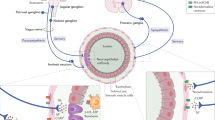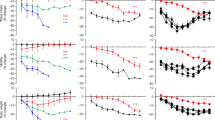Abstract
Crosstalk between the autonomic nervous system and the immune system by means of the sympathetic and parasympathetic pathways is a critical process in host defence. Activation of the sympathetic nervous system results in the release of catecholamines as well as neuropeptide Y (NPY). Here, we investigated whether phagocytes are capable of the de novo production of NPY, as has been described for catecholamines. We show that the synthesis of NPY and its Y1 receptor (Y1R) is increased in phagocytes in lungs following severe influenza virus infection. The genetic deletion of Npy or Y1r specifically in phagocytes greatly improves the pathology of severe influenza virus infection, which is characterized by excessive virus replication and pulmonary inflammation. Mechanistically, it is the induction of suppressor of cytokine signalling 3 (SOCS3) via NPY–Y1R activation that is responsible for impaired antiviral response and promoting pro-inflammatory cytokine production, thereby enhancing the pathology of influenza virus infection. Thus, direct regulation of the NPY–Y1R–SOCS3 pathway on phagocytes may act as a fine-tuner of an innate immune response to virus infection, which could be a therapeutic target for lethal influenza virus infection.
This is a preview of subscription content, access via your institution
Access options
Access Nature and 54 other Nature Portfolio journals
Get Nature+, our best-value online-access subscription
$29.99 / 30 days
cancel any time
Subscribe to this journal
Receive 12 digital issues and online access to articles
$119.00 per year
only $9.92 per issue
Buy this article
- Purchase on Springer Link
- Instant access to full article PDF
Prices may be subject to local taxes which are calculated during checkout





Similar content being viewed by others
Data availability
Nucleotide sequencing data that support the findings of this study have been deposited in Sequenced Read Archive in the DNA Data Bank of Japan (DDBJ) and are available under the accession number DRA007253. The data that support the findings of this study are available from the corresponding author upon request.
References
Clark, N. M. & Lynch, J. P. 3rd. Influenza: epidemiology, clinical features, therapy, and prevention. Semin. Respir. Crit. Care Med. 32, 373–392 (2011).
Beigel, J. H. et al. Avian influenza A (H5N1) infection in humans. N. Engl. J. Med. 353, 1374–1385 (2005).
Tracey, K. J. The inflammatory reflex. Nature 420, 853–859 (2002).
Sternberg, E. M. Neural regulation of innate immunity: a coordinated nonspecific host response to pathogens. Nat. Rev. Immunol. 6, 318–328 (2006).
Flierl, M. A. et al. Phagocyte-derived catecholamines enhance acute inflammatory injury. Nature 449, 721–725 (2007).
Lundberg, J. M., Rudehill, A., Sollevi, A., Fried, G. & Wallin, G. Co-release of neuropeptide Y and noradrenaline from pig spleen in vivo: importance of subcellular storage, nerve impulse frequency and pattern, feedback regulation and resupply by axonal transport. Neuroscience 28, 475–486 (1989).
Bedoui, S. et al. Relevance of neuropeptide Y for the neuroimmune crosstalk. J. Neuroimmunol. 134, 1–11 (2003).
Wheway, J., Herzog, H. & Mackay, F. NPY and receptors in immune and inflammatory diseases. Curr. Top. Med. Chem. 7, 1743–1752 (2007).
Dimitrijevic, M. & Stanojevic, S. The intriguing mission of neuropeptide Y in the immune system. Amino Acids 45, 41–53 (2013).
Yoshimura, A., Naka, T. & Kubo, M. SOCS proteins, cytokine signalling and immune regulation. Nat. Rev. Immunol. 7, 454–465 (2007).
Linossi, E. M., Babon, J. J., Hilton, D. J. & Nicholson, S. E. Suppression of cytokine signaling: the SOCS perspective. Cytokine Growth Factor Rev. 24, 241–248 (2013).
Carow, B. & Rottenberg, M. E. SOCS3, a major regulator of infection and inflammation. Front. Immunol. 5, 58 (2014).
Mahony, R., Ahmed, S., Diskin, C. & Stevenson, N. J. SOCS3 revisited: a broad regulator of disease, now ready for therapeutic use? Cell. Mol. Life Sci. 73, 3323–3336 (2016).
Vijayakumar, P. et al. Analysis of the crow lung transcriptome in response to infection with highly pathogenic H5N1 avian influenza virus. Gene 559, 77–85 (2015).
Ahmed, C. M., Dabelic, R., Bedoya, S. K., Larkin, J. 3rd & Johnson, H. M. A SOCS1/3 antagonist peptide protects mice against lethal infection with influenza a virus. Front. Immunol. 6, 574 (2015).
Ichikawa, A. et al. CXCL10–CXCR3 enhances the development of neutrophil-mediated fulminant lung injury of viral and nonviral origin. Am. J. Respir. Crit. Care Med. 187, 65–77 (2013).
Morita, M. et al. The lipid mediator protectin D1 inhibits influenza virus replication and improves severe influenza. Cell 153, 112–125 (2013).
van den Pol, A. N. et al. Neuromedin B and gastrin-releasing peptide excite arcuate nucleus neuropeptide Y neurons in a novel transgenic mouse expressing strong Renilla green fluorescent protein in NPY neurons. J. Neurosci. 29, 4622–4639 (2009).
Kuroda, E. et al. Inhaled fine particles induce alveolar macrophage death and interleukin-1α release to promote inducible bronchus-associated lymphoid tissue formation. Immunity 45, 1299–1310 (2016).
Misharin, A. V., Morales-Nebreda, L., Mutlu, G. M., Budinger, G. R. & Perlman, H. Flow cytometric analysis of macrophages and dendritic cell subsets in the mouse lung. Am. J. Respir. Cell Mol. Biol. 49, 503–510 (2013).
Zaynagetdinov, R. et al. Identification of myeloid cell subsets in murine lungs using flow cytometry. Am. J. Respir. Cell Mol. Biol. 49, 180–189 (2013).
Weirauch, M. T. et al. Determination and inference of eukaryotic transcription factor sequence specificity. Cell 158, 1431–1443 (2014).
Kostrzewa, R. M. & Jacobowitz, D. M. Pharmacological actions of 6-hydroxydopamine. Pharmacol. Rev. 26, 199–288 (1974).
Cline, T. D., Beck, D. & Bianchini, E. Influenza virus replication in macrophages: balancing protection and pathogenesis. J. Gen. Virol. 98, 2401–2412 (2017).
White, M. R. et al. Collectins, H-ficolin and LL-37 reduce influence viral replication in human monocytes and modulate virus-induced cytokine production. Innate Immun. 23, 77–88 (2017).
Dimitrijevic, M., Stanojevic, S., Vujic, V., Beck-Sickinger, A. & von Horsten, S. Neuropeptide Y and its receptor subtypes specifically modulate rat peritoneal macrophage functions in vitro: counter regulation through Y1 and Y2/5 receptors. Regul. Pept. 124, 163–172 (2005).
Wheway, J. et al. A fundamental bimodal role for neuropeptide Y1 receptor in the immune system. J. Exp. Med. 202, 1527–1538 (2005).
Clausen, B. E., Burkhardt, C., Reith, W., Renkawitz, R. & Forster, I. Conditional gene targeting in macrophages and granulocytes using LysMcre mice. Transgenic Res. 8, 265–277 (1999).
Pauli, E. K. et al. Influenza A virus inhibits type I IFN signaling via NF-κB-dependent induction of SOCS-3 expression. PLoS Pathog. 4, e1000196 (2008).
Bode, J. G. et al. IFN-α antagonistic activity of HCV core protein involves induction of suppressor of cytokine signaling-3. FASEB J. 17, 488–490 (2003).
Moore, E. C., Barber, J. & Tripp, R. A. Respiratory syncytial virus (RSV) attachment and nonstructural proteins modify the type I interferon response associated with suppressor of cytokine signaling (SOCS) proteins and IFN-stimulated gene-15 (ISG15). Virol. J. 5, 116 (2008).
Akhtar, L. N. et al. Suppressor of cytokine signaling 3 inhibits antiviral IFN-beta signaling to enhance HIV-1 replication in macrophages. J. Immunol. 185, 2393–2404 (2010).
Kortlever, R. M. et al. Myc cooperates with ras by programming inflammation and immune suppression. Cell 171, 1301–1315 (2017).
Londhe, V. A. et al. CXCR2 is critical for dsRNA-induced lung injury: relevance to viral lung infection. J. Inflamm. 2, 4 (2005).
Li, S. et al. Epithelium-generated neuropeptide Y induces smooth muscle contraction to promote airway hyperresponsiveness. J. Clin. Invest. 126, 1978–1982 (2016).
Lu, Y. & Ho, R. C. An association between neuropeptide Y levels and leukocyte subsets in stress-exacerbated asthmatic mice. Neuropeptides 57, 53–58 (2016).
Singer, K. et al. Neuropeptide Y is produced by adipose tissue macrophages and regulates obesity-induced inflammation. PLoS ONE 8, e57929 (2013).
Yasukawa, H. et al. IL-6 induces an anti-inflammatory response in the absence of SOCS3 in macrophages. Nat. Immunol. 4, 551–556 (2003).
Zaloudikova, M. et al. Depletion of alveolar macrophages attenuates hypoxic pulmonary hypertension but not hypoxia-induced increase in serum concentration of MCP-1. Physiol. Res. 65, 763–768 (2016).
Grebe, K. M. et al. Cutting edge: sympathetic nervous system increases proinflammatory cytokines and exacerbates influenza A virus pathogenesis. J. Immunol. 184, 540–544 (2010).
Daidoji, T. et al. H5N1 avian influenza virus induces apoptotic cell death in mammalian airway epithelial cells. J. Virol. 82, 11294–11307 (2008).
Imai, Y. et al. Identification of oxidative stress and Toll-like receptor 4 signaling as a key pathway of acute lung injury. Cell 133, 235–249 (2008).
Imai, Y. et al. Angiotensin-converting enzyme 2 protects from severe acute lung failure. Nature 436, 112–116 (2005).
Belperio, J. A. et al. Critical role for CXCR2 and CXCR2 ligands during the pathogenesis of ventilator-induced lung injury. J. Clin. Invest. 110, 1703–1716 (2002).
Lu, Y. et al. Loss of SOCS3 gene expression converts STAT3 function from anti-apoptotic to pro-apoptotic. J. Biol. Chem. 281, 36683–36690 (2006).
Kim, D., Langmead, B. & Salzberg, S. L. HISAT: a fast spliced aligner with low memory requirements. Nat. Methods 12, 357–360 (2015).
Liao, Y., Smyth, G. K. & Shi, W. featureCounts: an efficient general purpose program for assigning sequence reads to genomic features. Bioinformatics 30, 923–930 (2014).
Robinson, M. D., McCarthy, D. J. & Smyth, G. K. edgeR: a Bioconductor package for differential expression analysis of digital gene expression data. Bioinformatics 26, 139–140 (2010).
Zambelli, F., Pesole, G. & Pavesi, G. Pscan: finding over-represented transcription factor binding site motifs in sequences from co-regulated or co-expressed genes. Nucleic Acids Res. 37, W247–W252 (2009).
Acknowledgements
The authors thank all members of their laboratories for helpful discussions. Y.Imai is supported by JSPS KAKENHI (S) grants 17H06179, 17K19693 and 15H05978. M.O. is supported by JSPS KAKENHI grant 17H06302. A.Y. is supported by JSPS KAKENHI grants 17H06175 and 18H05376, and AMED-CREST grants 18gm1110009 and 18gm0510019. K.K. is supported by JSPS KAKENHI grants 30733422, 16K19013, 17H04028 and JST PRESTO grant JPMJPR13MD. H.O. is supported by the Core Research for Evolutional Science and Technology (JPMJCR14W3-CREST). Y.Imai is supported by the Takeda Science Foundation and the Uehara Memorial Foundation. The authors acknowledge the NGS core facility of the Genome Information Research Center at the Research Institute for Microbial Diseases of Osaka University for their support with RNA-seq.
Author information
Authors and Affiliations
Contributions
K.K., S.U., A.S.S., J.M.P., A.Y., H.O., H.H. and Y.Imai conceived the study and designed the experiments. S.F., M.H., Y.Ichida, D.L., E.K., K.J.I., H.T., M.G., H.I., R.H. and H.O. performed the experiments. S.M., M.O. Y.Ichida, and Y.Imai analysed the data. Y.Imai and H.H. wrote the manuscript with input from all authors.
Corresponding author
Ethics declarations
Competing interests
The authors declare no competing interests.
Additional information
Publisher’s note: Springer Nature remains neutral with regard to jurisdictional claims in published maps and institutional affiliations.
Supplementary information
Supplementary Information
Supplementary Figures 1–4 and uncropped data for blots and gels.
Supplementary Table 1
This table contains a list of antibodies used in the study.
Supplementary Table 2
This table contains a list of sequences of qPCR primers used in the study.
Rights and permissions
About this article
Cite this article
Fujiwara, S., Hoshizaki, M., Ichida, Y. et al. Pulmonary phagocyte-derived NPY controls the pathology of severe influenza virus infection. Nat Microbiol 4, 258–268 (2019). https://doi.org/10.1038/s41564-018-0289-1
Received:
Accepted:
Published:
Issue Date:
DOI: https://doi.org/10.1038/s41564-018-0289-1



